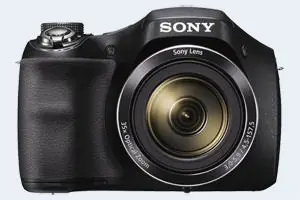Nikon D3200 vs Sony H300
The Nikon D3200 and the Sony Cyber-shot DSC-H300 are two digital cameras that were revealed to the public, respectively, in April 2012 and February 2014. The D3200 is a DSLR, while the H300 is a fixed lens compact. The cameras are based on an APS-C (D3200) and a 1/2.3-inch (H300) sensor. The Nikon has a resolution of 24.1 megapixels, whereas the Sony provides 19.9 MP.
Below is an overview of the main specs of the two cameras as a starting point for the comparison.

Check D3200 offers at
ebay.com

Check H300 offers at
ebay.com
Going beyond this snapshot of core features and characteristics, what are the differences between the Nikon D3200 and the Sony Cyber-shot DSC-H300? Which one should you buy? Read on to find out how these two cameras compare with respect to their body size, their imaging sensors, their shooting features, their input-output connections, and their reception by expert reviewers.
Body comparison
The side-by-side display below illustrates the physical size and weight of the Nikon D3200 and the Sony H300. The two cameras are presented according to their relative size. Three consecutive perspectives from the front, the top, and the back are available. All width, height and depth measures are rounded to the nearest millimeter.
The D3200 can be obtained in two different colors (black, red), while the H300 is only available in black.
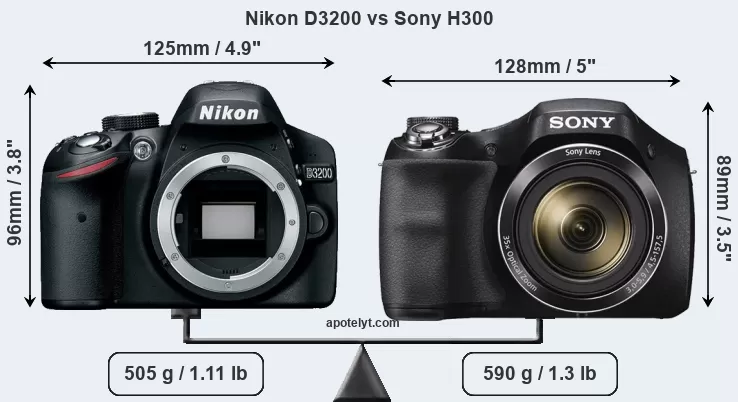
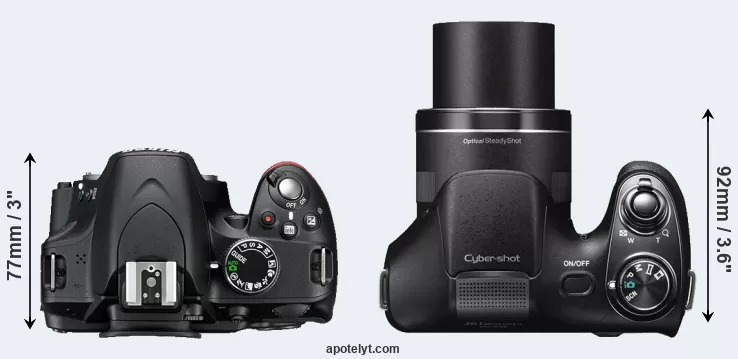
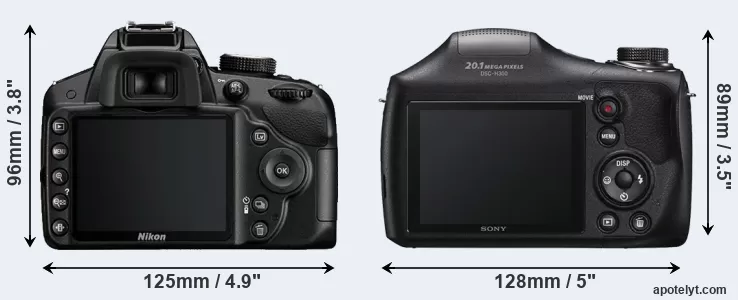
If the front view area (width x height) of the cameras is taken as an aggregate measure of their size, the Sony H300 is notably smaller (5 percent) than the Nikon D3200. In this context, it is worth noting that neither the D3200 nor the H300 are weather-sealed.
The above size and weight comparisons are to some extent incomplete and possibly misleading, as the H300 has a lens built in, whereas the D3200 is an interchangeable lens camera that requires a separate lens. Attaching the latter will add extra weight and bulk to the setup. You can compare the optics available for the D3200 and their specifications in the Nikon Lens Catalog.
The adjacent table lists the principal physical characteristics of the two cameras alongside a wider set of alternatives. In case you want to display and compare another camera duo, you can use the CAM-parator app to select your camera combination among a large number of options.

| Camera Model |
Camera Width |
Camera Height |
Camera Depth |
Camera Weight |
Battery Life |
Weather Sealing |
Camera Launch |
Launch Price (USD) |
Street Price |
||
|---|---|---|---|---|---|---|---|---|---|---|---|
| 1. | Nikon D3200 | 125 mm | 96 mm | 77 mm | 505 g | 540 | n | Apr 2012 | 599 | ebay.com | |
| 2. | Sony H300 | 128 mm | 89 mm | 92 mm | 590 g | 350 | n | Feb 2014 | 219 | ebay.com | |
| 3. | Canon SX610 | 105 mm | 61 mm | 27 mm | 191 g | 270 | n | Jan 2015 | 249 | ebay.com | |
| 4. | Nikon D3000 | 126 mm | 97 mm | 64 mm | 536 g | 500 | n | Jul 2009 | 599 | ebay.com | |
| 5. | Nikon D3100 | 124 mm | 96 mm | 75 mm | 505 g | 550 | n | Aug 2010 | 599 | ebay.com | |
| 6. | Nikon D3300 | 124 mm | 98 mm | 76 mm | 430 g | 700 | n | Jan 2014 | 499 | ebay.com | |
| 7. | Nikon D3400 | 124 mm | 98 mm | 76 mm | 445 g | 1200 | n | Aug 2016 | 499 | ebay.com | |
| 8. | Nikon D5100 | 128 mm | 97 mm | 79 mm | 560 g | 660 | n | Apr 2011 | 749 | ebay.com | |
| 9. | Nikon D5200 | 129 mm | 98 mm | 78 mm | 555 g | 500 | n | Nov 2012 | 749 | ebay.com | |
| 10. | Nikon D5300 | 125 mm | 98 mm | 76 mm | 480 g | 600 | n | Oct 2013 | 799 | ebay.com | |
| 11. | Nikon D5500 | 124 mm | 97 mm | 70 mm | 470 g | 820 | n | Jan 2015 | 899 | ebay.com | |
| 12. | Nikon D5600 | 124 mm | 97 mm | 70 mm | 465 g | 970 | n | Nov 2016 | 699 | ebay.com | |
| 13. | Sony A58 | 129 mm | 95 mm | 78 mm | 492 g | 690 | n | Feb 2013 | 599 | ebay.com | |
| 14. | Sony H200 | 123 mm | 83 mm | 87 mm | 530 g | 240 | n | Jan 2013 | 249 | ebay.com | |
| 15. | Sony H400 | 130 mm | 95 mm | 122 mm | 628 g | 300 | n | Feb 2014 | 319 | ebay.com | |
| 16. | Sony HX90V | 102 mm | 58 mm | 36 mm | 245 g | 360 | n | Apr 2015 | 429 | ebay.com | |
| 17. | Sony HX400V | 130 mm | 93 mm | 103 mm | 660 g | 300 | n | Feb 2014 | 499 | ebay.com | |
| Note: Measurements and pricing do not include easily detachable parts, such as add-on or interchangeable lenses or optional viewfinders. | |||||||||||
The price is, of course, an important factor in any camera decision. The listed launch prices provide an indication of the market segment that the manufacturer of the cameras have been targeting. The H300 was launched at a lower price than the D3200, despite having a lens built in. Usually, retail prices stay at first close to the launch price, but after several months, discounts become available. Later in the product cycle and, in particular, when the replacement model is about to appear, further discounting and stock clearance sales often push the camera price considerably down. Then, after the new model is out, very good deals can frequently be found on the pre-owned market.
Sensor comparison
The imaging sensor is at the core of digital cameras and its size is one of the main determining factors of image quality. A large sensor will generally have larger individual pixels that offer better low-light sensitivity, provide wider dynamic range, and have richer color-depth than smaller pixels in a sensor of the same technological generation. Moreover, a large sensor camera will give the photographer more control over depth-of-field in the image and, thus, the ability to better isolate a subject from the background. On the downside, larger sensors tend to be more expensive and lead to bigger and heavier cameras and lenses.
Of the two cameras under consideration, the Nikon D3200 features an APS-C sensor and the Sony H300 a 1/2.3-inch sensor. The sensor area in the H300 is 92 percent smaller. As a result of these sensor size differences, the cameras have a format factor of, respectively, 1.5 and 5.6. The sensor in the D3200 has a native 3:2 aspect ratio, while the one in the H300 offers a 4:3 aspect.
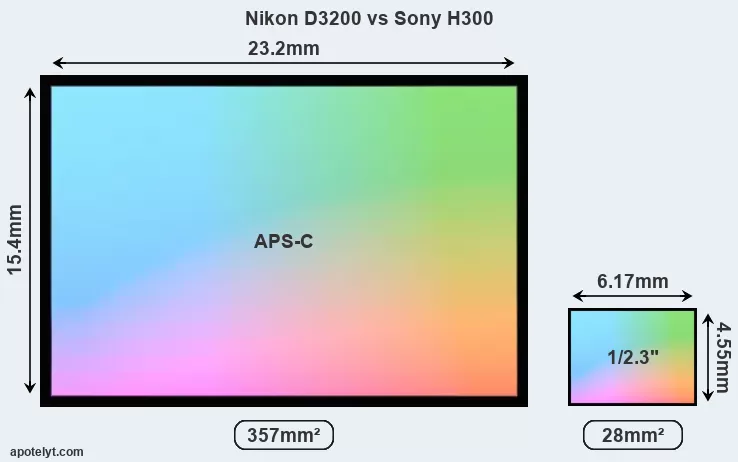
With 24.1MP, the D3200 offers a higher resolution than the H300 (19.9MP), but the D3200 nevertheless has larger individual pixels (pixel pitch of 3.85μm versus 1.19μm for the H300) due to its larger sensor. However, the H300 is a somewhat more recent model (by 1 year and 9 months) than the D3200, and its sensor might have benefitted from technological advances during this time that enhance the light gathering capacity of its pixels. Coming back to sensor resolution, it should be mentioned that the H300 has no anti-alias filter installed, so that it can capture all the detail its sensor resolves.
The resolution advantage of the Nikon D3200 implies greater flexibility for cropping images or the possibility to print larger pictures. The maximum print size of the D3200 for good quality output (200 dots per inch) amounts to 30.1 x 20 inches or 76.4 x 50.8 cm, for very good quality (250 dpi) 24.1 x 16 inches or 61.1 x 40.6 cm, and for excellent quality (300 dpi) 20.1 x 13.3 inches or 50.9 x 33.9 cm. The corresponding values for the Sony H300 are 25.8 x 19.3 inches or 65.4 x 49.1 cm for good quality, 20.6 x 15.5 inches or 52.3 x 39.3 cm for very good quality, and 17.2 x 12.9 inches or 43.6 x 32.7 cm for excellent quality prints.
The Nikon D3200 has a native sensitivity range from ISO 100 to ISO 6400, which can be extended to ISO 100-12800. The corresponding ISO settings for the Sony Cyber-shot DSC-H300 are ISO 80 to ISO 3200 (no boost).
In terms of underlying technology, the D3200 is build around a CMOS sensor, while the H300 uses a CCD imager. Both cameras use a Bayer filter for capturing RGB colors on a square grid of photosensors. This arrangement is found in most digital cameras.
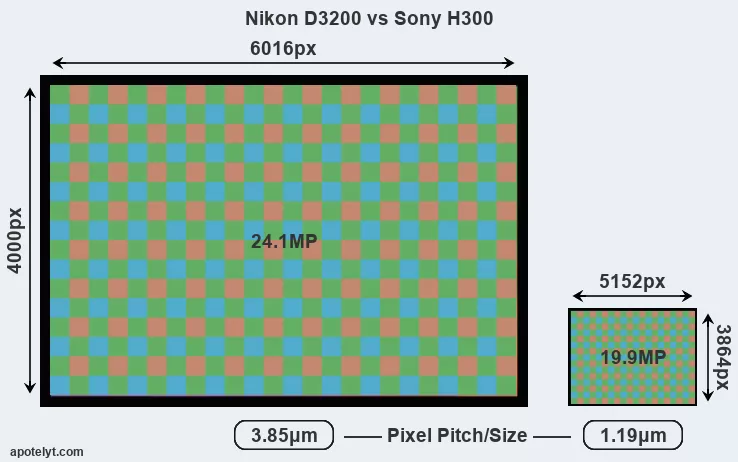
Since 2007, DXO Mark has published sensor performance measurements that have been derived using a consistent methodology. This service determines an overall sensor rating, as well as sub-scores for low-light sensitivity ("DXO Sports"), dynamic range ("DXO Landscape"), and color depth ("DXO Portrait"). The following table provides an overview of the physical sensor characteristics, as well as the sensor quality measurements for a selection of comparators.

| Camera Model |
Sensor Class |
Resolution (MP) |
Horiz. Pixels |
Vert. Pixels |
Video Format |
DXO Portrait |
DXO Landscape |
DXO Sports |
DXO Overall |
||
|---|---|---|---|---|---|---|---|---|---|---|---|
| 1. | Nikon D3200 | APS-C | 24.1 | 6016 | 4000 | 1080/30p | 24.1 | 13.2 | 1131 | 81 | |
| 2. | Sony H300 | 1/2.3 | 19.9 | 5152 | 3864 | 720/30p | 20.1 | 11.4 | 630 | 45 | |
| 3. | Canon SX610 | 1/2.3 | 20.2 | 5184 | 3888 | 1080/30p | 20.2 | 11.6 | 712 | 47 | |
| 4. | Nikon D3000 | APS-C | 10.0 | 3872 | 2592 | none | 22.3 | 11.1 | 563 | 62 | |
| 5. | Nikon D3100 | APS-C | 14.2 | 4608 | 3072 | 1080/24p | 22.5 | 11.3 | 919 | 67 | |
| 6. | Nikon D3300 | APS-C | 24.0 | 6000 | 4000 | 1080/60p | 24.3 | 12.8 | 1385 | 82 | |
| 7. | Nikon D3400 | APS-C | 24.0 | 6000 | 4000 | 1080/60p | 24.8 | 13.9 | 1192 | 86 | |
| 8. | Nikon D5100 | APS-C | 16.1 | 4928 | 3264 | 1080/30p | 23.5 | 13.6 | 1183 | 80 | |
| 9. | Nikon D5200 | APS-C | 24.0 | 6000 | 4000 | 1080/60i | 24.2 | 13.9 | 1284 | 84 | |
| 10. | Nikon D5300 | APS-C | 24.0 | 6000 | 4000 | 1080/60p | 24.0 | 13.9 | 1338 | 83 | |
| 11. | Nikon D5500 | APS-C | 24.0 | 6000 | 4000 | 1080/60p | 24.1 | 14.0 | 1438 | 84 | |
| 12. | Nikon D5600 | APS-C | 24.0 | 6000 | 4000 | 1080/60p | 24.1 | 14.0 | 1306 | 84 | |
| 13. | Sony A58 | APS-C | 19.8 | 5456 | 3632 | 1080/60i | 23.3 | 12.5 | 753 | 74 | |
| 14. | Sony H200 | 1/2.3 | 15.2 | 5184 | 2930 | 720/30p | 19.9 | 11.2 | 529 | 44 | |
| 15. | Sony H400 | 1/2.3 | 19.9 | 5152 | 3864 | 720/30p | 20.1 | 11.4 | 630 | 45 | |
| 16. | Sony HX90V | 1/2.3 | 18.0 | 4896 | 3672 | 1080/60p | 20.2 | 11.6 | 738 | 47 | |
| 17. | Sony HX400V | 1/2.3 | 20.2 | 5184 | 3888 | 1080/60p | 20.1 | 11.4 | 629 | 45 | |
| Note: DXO values in italics represent estimates based on sensor size and age. | |||||||||||
Many modern cameras are not only capable of taking still images, but also of capturing video footage. Both cameras under consideration have a sensor with sufficiently fast read-out times for moving pictures, but the D3200 provides a higher video resolution than the H300. It can shoot video footage at 1080/30p, while the Sony is limited to 720/30p.
Feature comparison
Apart from body and sensor, cameras can and do differ across a variety of features. For example, the D3200 has an optical viewfinder, which can be very useful when shooting in bright sunlight. In contrast, the H300 relies on live view and the rear LCD for framing. The table below summarizes some of the other core capabilities of the Nikon D3200 and Sony H300 in connection with corresponding information for a sample of similar cameras.

| Camera Model |
Viewfinder (Type or 000 dots) |
Control Panel (yes/no) |
LCD Specifications (inch/000 dots) |
LCD Attach- ment |
Touch Screen (yes/no) |
Max Shutter Speed * |
Max Shutter Flaps * |
Built-in Flash (yes/no) |
Built-in Image Stab |
||
|---|---|---|---|---|---|---|---|---|---|---|---|
| 1. | Nikon D3200 | optical | n | 3.0 / 921 | fixed | n | 1/4000s | 4.0/s | Y | n | |
| 2. | Sony H300 | none | n | 3.0 / 460 | fixed | n | 1/1500s | 0.8/s | Y | Y | |
| 3. | Canon SX610 | none | n | 3.0 / 922 | fixed | n | 1/2000s | 2.5/s | Y | Y | |
| 4. | Nikon D3000 | optical | n | 3.0 / 230 | fixed | n | 1/4000s | 3.0/s | Y | n | |
| 5. | Nikon D3100 | optical | n | 3.0 / 230 | fixed | n | 1/4000s | 3.0/s | Y | n | |
| 6. | Nikon D3300 | optical | n | 3.0 / 921 | fixed | n | 1/4000s | 5.0/s | Y | n | |
| 7. | Nikon D3400 | optical | n | 3.0 / 921 | fixed | n | 1/4000s | 5.0/s | Y | n | |
| 8. | Nikon D5100 | optical | n | 3.0 / 921 | swivel | n | 1/4000s | 4.0/s | Y | n | |
| 9. | Nikon D5200 | optical | n | 3.0 / 921 | swivel | n | 1/4000s | 5.0/s | Y | n | |
| 10. | Nikon D5300 | optical | n | 3.2 / 1037 | swivel | n | 1/4000s | 5.0/s | Y | n | |
| 11. | Nikon D5500 | optical | n | 3.2 / 1037 | swivel | Y | 1/4000s | 5.0/s | Y | n | |
| 12. | Nikon D5600 | optical | n | 3.2 / 1037 | swivel | Y | 1/4000s | 5.0/s | Y | n | |
| 13. | Sony A58 | 1440 | n | 2.7 / 460 | tilting | n | 1/4000s | 5.0/s | Y | Y | |
| 14. | Sony H200 | none | n | 3.0 / 460 | fixed | n | 1/1500s | 0.8/s | Y | Y | |
| 15. | Sony H400 | 210 | n | 3.0 / 460 | fixed | n | 1/2000s | 0.7/s | Y | Y | |
| 16. | Sony HX90V | 638 | n | 3.0 / 921 | tilting | n | 1/2000s | 10.0/s | Y | Y | |
| 17. | Sony HX400V | 210 | n | 3.0 / 921 | tilting | n | 1/4000s | 10.0/s | Y | Y | |
| Note: *) Information refers to the mechanical shutter, unless the camera only has an electronic one. | |||||||||||
The D3200 writes its imaging data to SDXC cards, while the H300 uses SDXC or Memory Stick PRO Duo cards. The D3200 supports UHS-I cards (Ultra High Speed data transfer of up to 104 MB/s), while the H300 cannot take advantage of Ultra High Speed SD cards.
Connectivity comparison
For some imaging applications, the extent to which a camera can communicate with its environment can be an important aspect in the camera decision process. The table below provides an overview of the connectivity of the Nikon D3200 and Sony Cyber-shot DSC-H300 and, in particular, the interfaces the cameras (and selected comparators) provide for accessory control and data transfer.

| Camera Model |
Hotshoe Port |
Internal Mic / Speaker |
Microphone Port |
Headphone Port |
HDMI Port |
USB Port |
WiFi Support |
NFC Support |
Bluetooth Support |
||
|---|---|---|---|---|---|---|---|---|---|---|---|
| 1. | Nikon D3200 | Y | mono / mono | Y | - | mini | 2.0 | - | - | - | |
| 2. | Sony H300 | - | mono / mono | - | - | micro | 2.0 | Y | - | - | |
| 3. | Canon SX610 | - | - / - | - | - | micro | 2.0 | Y | Y | - | |
| 4. | Nikon D3000 | Y | - / - | - | - | - | 2.0 | - | - | - | |
| 5. | Nikon D3100 | Y | mono / mono | - | - | mini | 2.0 | - | - | - | |
| 6. | Nikon D3300 | Y | mono / mono | Y | - | mini | 2.0 | - | - | - | |
| 7. | Nikon D3400 | Y | mono / mono | - | - | mini | 2.0 | - | - | Y | |
| 8. | Nikon D5100 | Y | mono / mono | Y | - | mini | 2.0 | - | - | - | |
| 9. | Nikon D5200 | Y | stereo / mono | Y | - | mini | 2.0 | - | - | - | |
| 10. | Nikon D5300 | Y | stereo / mono | Y | - | mini | 2.0 | Y | - | - | |
| 11. | Nikon D5500 | Y | stereo / mono | Y | - | mini | 2.0 | Y | - | - | |
| 12. | Nikon D5600 | Y | stereo / mono | Y | - | mini | 2.0 | Y | Y | Y | |
| 13. | Sony A58 | Y | stereo / mono | Y | - | mini | 2.0 | - | - | - | |
| 14. | Sony H200 | - | mono / mono | - | - | - | 2.0 | - | - | - | |
| 15. | Sony H400 | - | mono / mono | - | - | micro | 2.0 | Y | - | - | |
| 16. | Sony HX90V | - | stereo / mono | - | - | micro | 2.0 | Y | Y | - | |
| 17. | Sony HX400V | Y | stereo / mono | - | - | micro | 2.0 | Y | Y | - |
It is notable that the D3200 has a hotshoe, while the H300 does not. This socket makes it possible to easily attach optional accessories, such as an external flash gun.
Both the D3200 and the H300 have been discontinued, but can regularly be found used on ebay. The D3200 was replaced by the Nikon D3300, while the H300 does not have a direct successor. Further information on the features and operation of the D3200 and H300 can be found, respectively, in the Nikon D3200 Manual (free pdf) or the online Sony H300 Manual.
Review summary
So what conclusions can be drawn? Is the Nikon D3200 better than the Sony H300 or vice versa? A synthesis of the relative strong points of each of the models is listed below.

Reasons to prefer the Nikon D3200:
- More detail: Offers more megapixels (24.1 vs 19.9MP) with a 12% higher linear resolution.
- Better moiré control: Has an anti-alias filter to avoid artificial patterns to appear in images.
- Better image quality: Features bigger pixels on a larger sensor for higher quality imaging.
- Richer colors: The pixel size advantage translates into images with better, more accurate colors.
- More dynamic range: Larger pixels capture a wider spectrum of light and dark details.
- Better low-light sensitivity: Larger pixels means good image quality even under poor lighting.
- Better video: Provides higher definition movie capture (1080/30p vs 720/30p).
- Better sound: Can connect to an external microphone for higher quality sound recording.
- Easier framing: Has an optical viewfinder for image composition and settings control.
- More detailed LCD: Has a higher resolution rear screen (921k vs 460k dots).
- Faster shutter: Has higher mechanical shutter speed (1/4000s vs 1/1500s) to freeze action.
- Faster burst: Shoots at higher frequency (4 vs 0.8 flaps/sec) to capture the decisive moment.
- More flexible: Can take a variety of interchangeable lenses, including specialty optics.
- Longer lasting: Can take more shots (540 versus 350) on a single battery charge.
- Better lighting: Features a hotshoe and can thus hold and trigger an external flash gun.
- Faster buffer clearing: Has an SD card interface that supports the UHS-I standard.
- More heavily discounted: Has been on the market for longer (launched in April 2012).

Advantages of the Sony Cyber-shot DSC-H300:
- Maximized detail: Lacks an anti-alias filter to exploit the sensor's full resolution potential.
- Ready to shoot: Comes with an integrated lens, while the D3200 requires a separate lens.
- Sharper images: Has stabilization technology built-in to reduce the impact of hand-shake.
- Easier file upload: Has wifi built in for automatic backup or image transfer to the web.
- More affordable: Was introduced at a lower price, despite coming with a built-in lens.
- More modern: Was introduced somewhat (1 year and 9 months) more recently.
If the count of relative strengths (bullet points above) is taken as a measure, the D3200 is the clear winner of the match-up (17 : 6 points). However, the relevance of individual strengths will vary across photographers, so that you might want to apply your own weighing scheme to the summary points when reflecting and deciding on a new camera. A professional sports photographer will view the differences between cameras in a way that diverges from the perspective of a street photog, and a person interested in family portraits has distinct needs from a landscape shooter. Hence, the decision which camera is best and worth buying is often a very personal one.
How about other alternatives? Do the specifications of the Nikon D3200 and the Sony H300 place the cameras among the top in their class? Find out in the latest Best DSLR Camera and Best Superzoom Camera listings whether the two cameras rank among the cream of the crop.
In any case, while the specs-based evaluation of cameras can be instructive in revealing their potential as photographic tools, it says little about, for example, the shooting experience and imaging performance of the D3200 and the H300 in practical situations. User reviews, such as those found at amazon, can sometimes inform about these issues, but such feedback is often incomplete, inconsistent, and biased.
Expert reviews
This is why expert reviews are important. The following table reports the overall ratings of the cameras as published by some of the major camera review sites (amateurphotographer [AP], cameralabs [CL], digitalcameraworld [DCW], dpreview [DPR], ephotozine [EPZ], photographyblog [PB]). As can be seen, the professional reviewers agree in many cases on the quality of different cameras, but sometimes their assessments diverge, reinforcing the earlier point that a camera decision is often a very personal choice.

| Camera Model |
AP score |
CL score |
DCW score |
DPR score |
EPZ score |
PB score |
Camera Launch |
Launch Price (USD) |
Street Price |
||
|---|---|---|---|---|---|---|---|---|---|---|---|
| 1. | Nikon D3200 | 5/5 | + + | .. | 73/100 | 4.5/5 | 4.5/5 | Apr 2012 | 599 | ebay.com | |
| 2. | Sony H300 | .. | + | .. | .. | 4.5/5 | 4/5 | Feb 2014 | 219 | ebay.com | |
| 3. | Canon SX610 | .. | .. | .. | .. | 4/5 | 4/5 | Jan 2015 | 249 | ebay.com | |
| 4. | Nikon D3000 | .. | + | .. | 72/100 | 4/5 | 4.5/5 | Jul 2009 | 599 | ebay.com | |
| 5. | Nikon D3100 | 5/5 | + + | .. | 72/100 | 4.5/5 | 4.5/5 | Aug 2010 | 599 | ebay.com | |
| 6. | Nikon D3300 | 3/5 | + | .. | 77/100 | 4.5/5 | 4.5/5 | Jan 2014 | 499 | ebay.com | |
| 7. | Nikon D3400 | 4/5 | + | 4/5 | 76/100 | 4/5 | 4.5/5 | Aug 2016 | 499 | ebay.com | |
| 8. | Nikon D5100 | 5/5 | + + | .. | 76/100 | 4.5/5 | 4.5/5 | Apr 2011 | 749 | ebay.com | |
| 9. | Nikon D5200 | 4/5 | + + | .. | 79/100 | 4.5/5 | 4.5/5 | Nov 2012 | 749 | ebay.com | |
| 10. | Nikon D5300 | 4/5 | + + | .. | 79/100 | 4.5/5 | 4.5/5 | Oct 2013 | 799 | ebay.com | |
| 11. | Nikon D5500 | 5/5 | + | .. | 79/100 | 4.5/5 | 4.5/5 | Jan 2015 | 899 | ebay.com | |
| 12. | Nikon D5600 | 4/5 | .. | 4/5 | 79/100 | 4.5/5 | 4/5 | Nov 2016 | 699 | ebay.com | |
| 13. | Sony A58 | 3/5 | .. | .. | .. | 4.5/5 | 4.5/5 | Feb 2013 | 599 | ebay.com | |
| 14. | Sony H200 | .. | .. | .. | .. | 3.5/5 | 3.5/5 | Jan 2013 | 249 | ebay.com | |
| 15. | Sony H400 | .. | o | .. | .. | 3.5/5 | 3.5/5 | Feb 2014 | 319 | ebay.com | |
| 16. | Sony HX90V | 4/5 | + + | .. | .. | 4/5 | 4.5/5 | Apr 2015 | 429 | ebay.com | |
| 17. | Sony HX400V | 4/5 | + + | .. | .. | 4/5 | 4/5 | Feb 2014 | 499 | ebay.com | |
| Note: (+ +) highly recommended; (+) recommended; (o) reviewed; (..) not available. | |||||||||||
Care should be taken when interpreting the review scores above, though. The assessments were made in relation to similar cameras of the same technological generation. A score, therefore, has to be seen in close connection to the price and market introduction time of the camera, and rating-comparisons among cameras that span long time periods or concern very differently equipped models make little sense. Also, please note that some of the review sites have changed their methodology and reporting over time.

Check D3200 offers at
ebay.com

Check H300 offers at
ebay.com
Other camera comparisons
Did this review help to inform your camera decision process? In case you are interested in seeing how other cameras pair up, just make a corresponding selection in the search boxes below. There is also a set of direct links to comparison reviews that other users of the CAM-parator app explored.
- Canon 6D Mark II vs Sony H300
- Canon 6D vs Nikon D3200
- Canon G12 vs Nikon D3200
- Canon M6 Mark II vs Sony H300
- Canon SX510 vs Sony H300
- Nikon 1 J5 vs Sony H300
- Nikon D3000 vs Nikon D3200
- Nikon D3200 vs Panasonic GX850
- Nikon D3200 vs Panasonic S1H
- Nikon D3200 vs Panasonic S5 II
- Nikon D70 vs Sony H300
- Olympus E-410 vs Sony H300
Specifications: Nikon D3200 vs Sony H300
Below is a side-by-side comparison of the specs of the two cameras to facilitate a quick review of their differences and common features.
| Camera Model | Nikon D3200 | Sony H300 |
|---|---|---|
| Camera Type | Digital single lens reflex | Fixed lens compact camera |
| Camera Lens | Nikon F mount lenses | 25-875mm f/3.4-6.5 |
| Launch Date | April 2012 | February 2014 |
| Launch Price | USD 599 | USD 219 |
| Sensor Specs | Nikon D3200 | Sony H300 |
| Sensor Technology | CMOS | CCD |
| Sensor Format | APS-C Sensor | 1/2.3" Sensor |
| Sensor Size | 23.2 x 15.4 mm | 6.17 x 4.55 mm |
| Sensor Area | 357.28 mm2 | 28.0735 mm2 |
| Sensor Diagonal | 27.8 mm | 7.7 mm |
| Crop Factor | 1.5x | 5.6x |
| Sensor Resolution | 24.1 Megapixels | 19.9 Megapixels |
| Image Resolution | 6016 x 4000 pixels | 5152 x 3864 pixels |
| Pixel Pitch | 3.85 μm | 1.19 μm |
| Pixel Density | 6.74 MP/cm2 | 70.91 MP/cm2 |
| Moiré control | Anti-Alias filter | no AA filter |
| Movie Capability | 1080/30p Video | 720/30p Video |
| ISO Setting | 100 - 6,400 ISO | 80 - 3,200 ISO |
| ISO Boost | 100 - 12,800 ISO | no Enhancement |
| Image Processor | EXPEED 3 | BIONZ |
| DXO Sensor Quality (score) | 81 | .. |
| DXO Color Depth (bits) | 24.1 | .. |
| DXO Dynamic Range (EV) | 13.2 | .. |
| DXO Low Light (ISO) | 1131 | .. |
| Screen Specs | Nikon D3200 | Sony H300 |
| Viewfinder Type | Optical viewfinder | no viewfinder |
| Viewfinder Field of View | 95% | |
| Viewfinder Magnification | 0.53x | |
| LCD Framing | Live View | Live View |
| Rear LCD Size | 3.0inch | 3.0inch |
| LCD Resolution | 921k dots | 460k dots |
| LCD Attachment | Fixed screen | Fixed screen |
| Shooting Specs | Nikon D3200 | Sony H300 |
| Focus System | Phase-detect AF | Contrast-detect AF |
| Continuous Shooting | 4 shutter flaps/s | 0.8 shutter flaps/s |
| Fill Flash | Built-in Flash | Built-in Flash |
| Storage Medium | SDXC cards | MS or SDXC cards |
| Single or Dual Card Slots | Single card slot | Single card slot |
| UHS card support | UHS-I | no |
| Connectivity Specs | Nikon D3200 | Sony H300 |
| External Flash | Hotshoe | no Hotshoe |
| USB Connector | USB 2.0 | USB 2.0 |
| HDMI Port | mini HDMI | micro HDMI |
| Microphone Port | External MIC port | no MIC socket |
| Wifi Support | no Wifi | Wifi built-in |
| Body Specs | Nikon D3200 | Sony H300 |
| Battery Type | Nikon EN-EL14 | Sony 4xAA |
| Battery Life (CIPA) | 540 shots per charge | 350 shots per charge |
| Body Dimensions |
125 x 96 x 77 mm (4.9 x 3.8 x 3.0 in) |
128 x 89 x 92 mm (5.0 x 3.5 x 3.6 in) |
| Camera Weight | 505 g (17.8 oz) | 590 g (20.8 oz) |

Check D3200 offers at
ebay.com

Check H300 offers at
ebay.com
Did you notice an error on this page? If so, please get in touch, so that we can correct the information.

